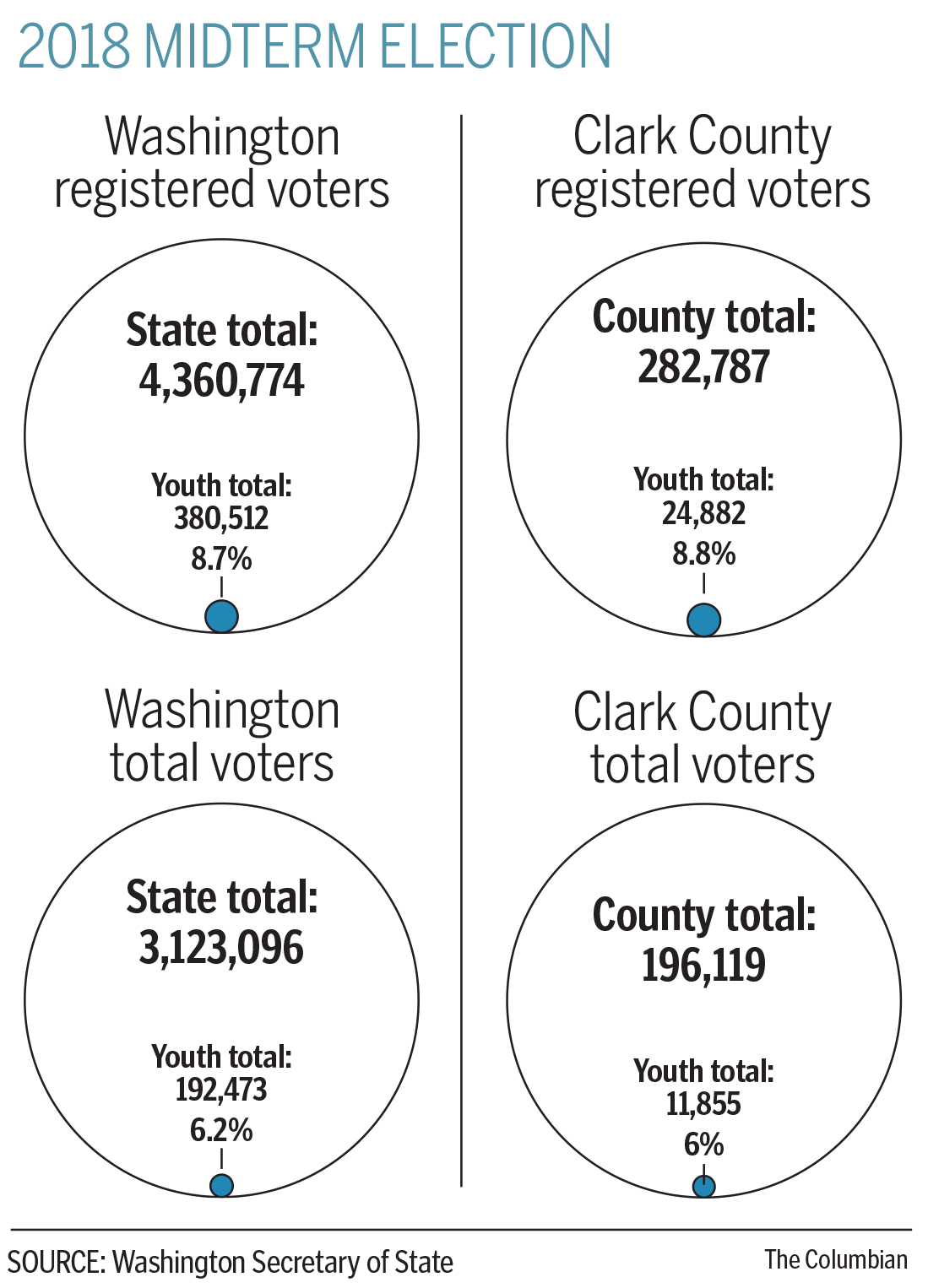Those ages 18-24 are increasingly making their voices heard throughout Clark County and Washington
Molly Elyse Urban’s first foray into politics was working at her student newspaper at Firm Foundation Christian School in Battle Ground.
There, she and a conservative friend would debate politics. They would read articles, discuss their beliefs and work to reach common ground despite their differences.
Those early conversations motivated Urban, now a 23-year-old Washington State University Vancouver senior, to become politically active. She volunteers on campaigns, has voted consistently since turning 18 and encourages her peers to be politically involved.
“I wanted to see real change in our local government and focus on issues that I cared about,” Urban said. “I think my school really cultivated an environment where people were encouraged to vote.”
There can be no question that the past year has been historic for young people like Urban, who say they’re motivated to vote by school shootings, environmental policy and bridging the political divide. And that energy appears to be translating into action.
A Columbian analysis found that in nearly all Washington counties, voters aged 18 to 24 turned out at higher rates in 2018 than in previous midterm elections. Across the state, youth voting was up by 10.3 percentage points from 2010.
Clark County saw youth voter turnout increase by about 8.9 percentage points in 2018 over 2010.
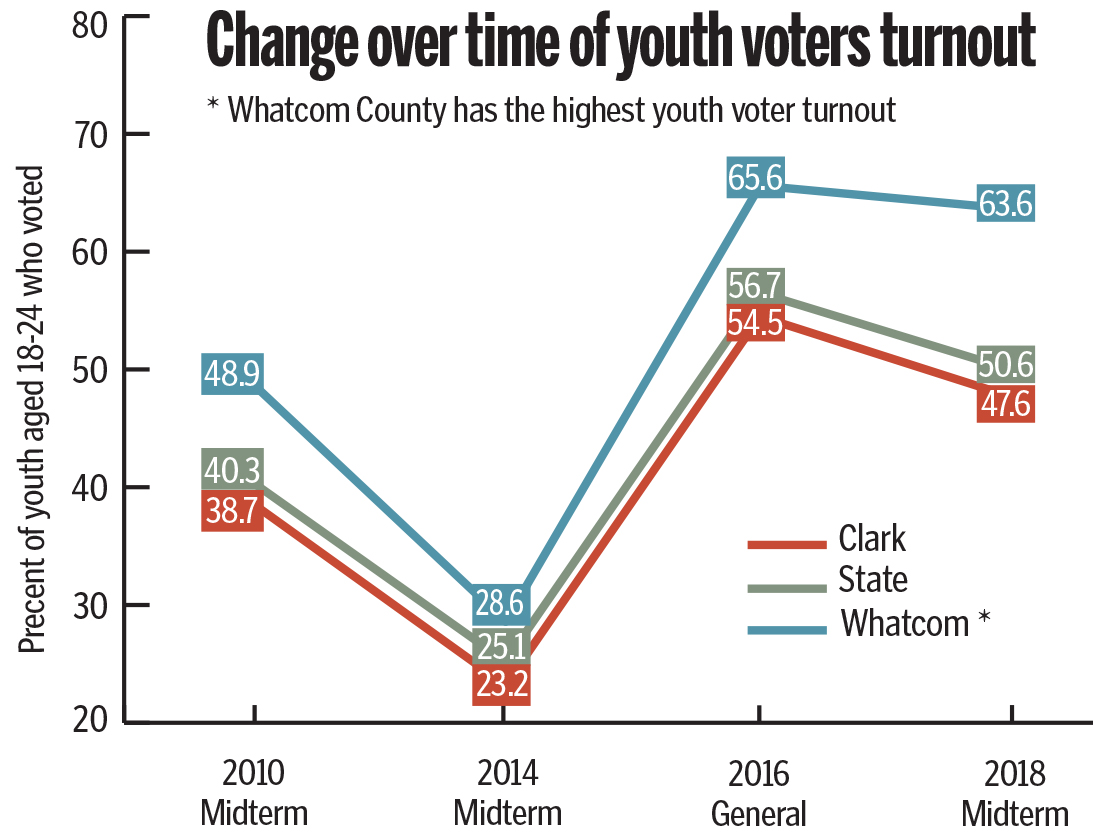
Clark County election officials have taken a backseat approach to increasing voter turnout. But elsewhere in Washington, officials are speaking at schools, launching voter registration campaigns and using social media to target young voters.
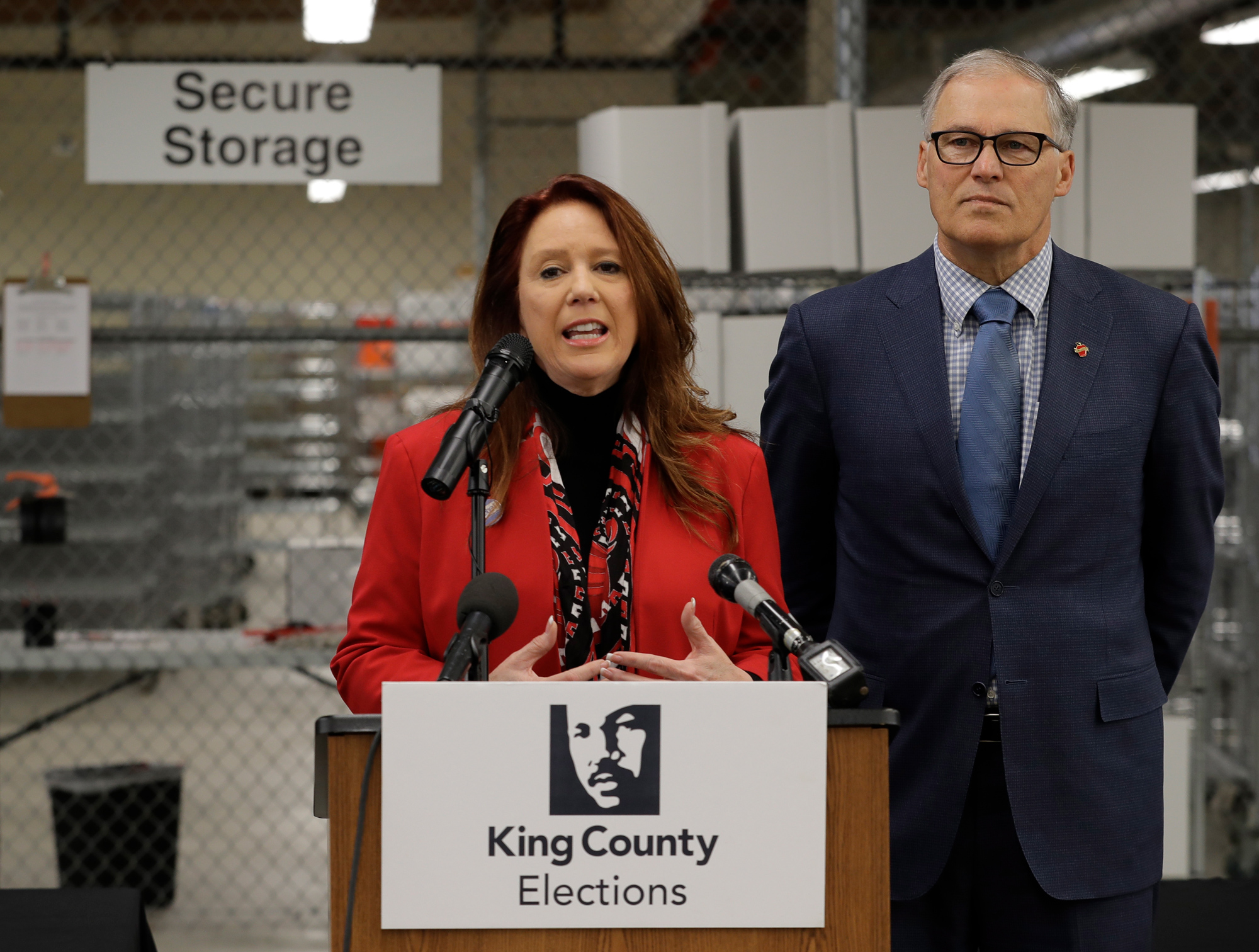
Associated Press
Secretary of State Kim Wyman, the Republican elected official responsible for overseeing elections, said youth voter engagement has been a priority for the office for decades. When The Columbian shared the results of its analysis, Wyman said she was pleased to see that more young people are casting ballots.
“I want them to see that youth have the same power you do,” Wyman said. “If you chose not to exercise that, you’re giving your power away.”
Driving turnout
Clark County Auditor Greg Kimsey, a Republican, said the county doesn’t dedicate resources to encourage more young people to vote.
“The thing that drives turnout is when there’s an issue or candidate on the ballot that people care about,” he said.
Other counties in Washington, however, have made it a point to encourage young voters to show up. Take King County, for instance. According to the Secretary of State’s Office, about 24,500 more voters between the ages of 18 and 24 cast ballots there in 2018 than in 2010. Turnout among young voters increased by 14.5 percentage points.
King County is fortunate, said Director of Elections Julie Wise, in that the office has access to funding to increase voter turnout. Since 2016, the county and the Seattle Foundation have provided grants to community-based organizations working to encourage more disenfranchised communities to vote. They’ve targeted voters of color, disabled voters and young voters. In 2018, they awarded $460,000 in grant funding to 33 different organizations.
The Washington Bus, a nonprofit organization promoting political participation by young people, received $20,000 in grant funding with the goal of getting young people not only to register to vote, but to be more broadly engaged in their communities.
Chris Esh, interim program director of The Washington Bus, said the organization started more than a decade ago as a “ragtag collection of 20-somethings” with a mission to see more young people holding political office.
“Our generation, as it starts to flex its muscles, is really going to start to realize the immense amount of power it has,” Esh said.
The organization conducts voter registrations at high schools, on college campuses, at music festivals and wherever young people congregate. Come election time, volunteers set out to knock on doors, staff phone banks and send text messages to voters reminding them to turn in their ballots.
Young voters at Washington Bus events are also encouraged to write Mad Libs-style pledge cards, promising they’ll vote in the upcoming election. The Washington Bus uses that information to remind voters to fill out their ballots.
Data from the organization suggest the effort is working. Of the 4,796 voters aged 18 to 24 who registered to vote with The Washington Bus or signed a pledge card, 3,413 returned their ballots. That’s 71.2 percent turnout, 20.6 percentage points more than youth voter turnout across the state.
Wise said she would never have guessed that filling out a pledge card would be as effective as social media in reaching youth.
“We’re trying to do innovative things in the elections department, and really lean into social media,” Wise said, adding that her office uses Snapchat and Instagram to target young voters.
Thurston County Auditor Mary Hall said it’s unclear if a 5.7 percent increase in youth voting in 2018 in that county is due to the political climate or simply an anomaly, but it’s something her office will be watching closely.
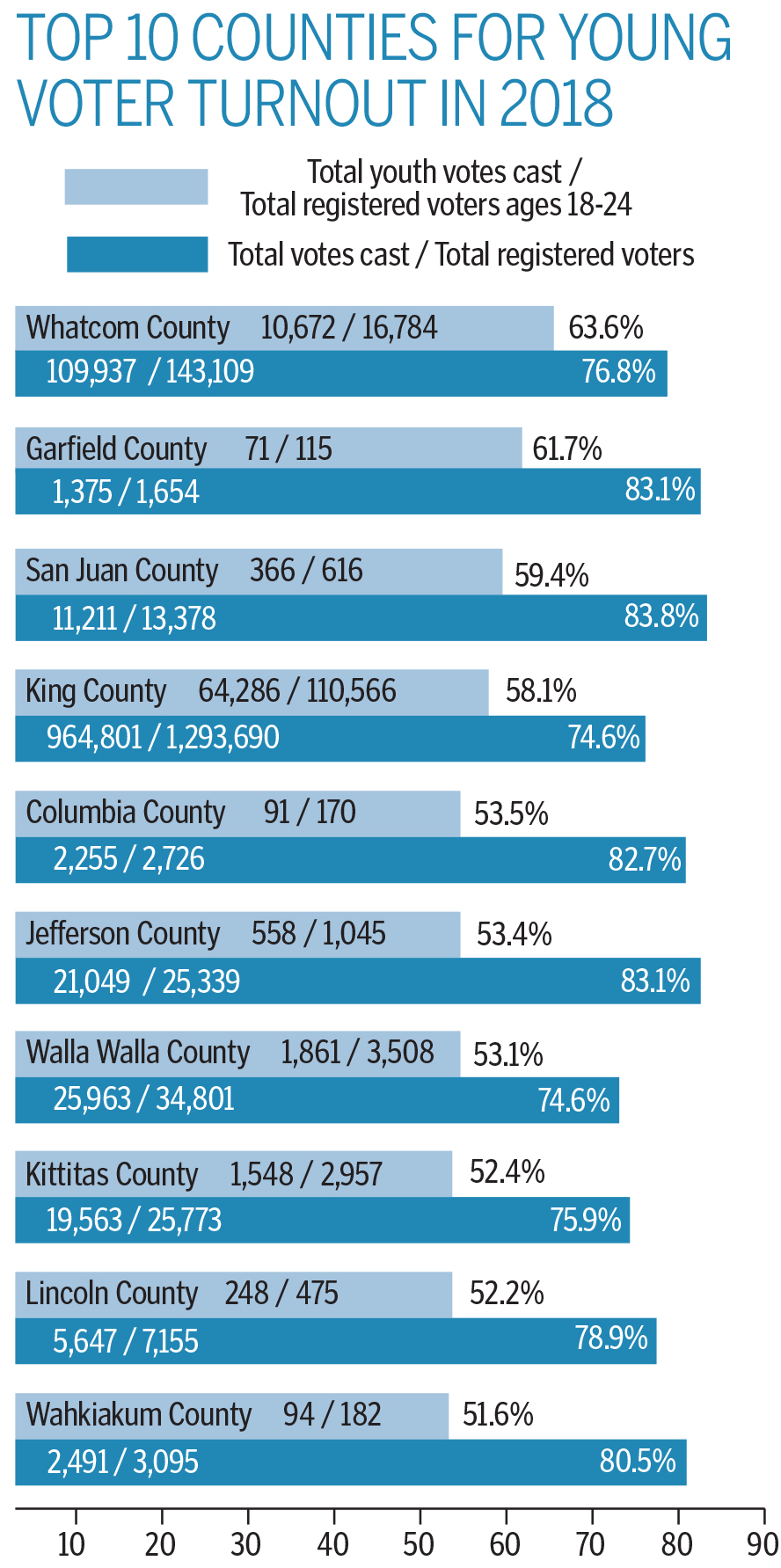
Like many others, Hall has focused on developing innovative ways to increase youth turnout. She turned to young voters for help. Thurston County is sponsoring a youth advisory board tasked with developing methods to encourage students to get engaged. Hall hopes the board will begin meeting within the next month.
“We determined the best way to go about this is to have the kids actually develop the program,” Hall said. If everything goes according to plan, the advisory board will be made up of high school juniors and seniors, with new members rotating in as students graduate.
“I think it’s important to point out to them how much power they really have,” she said. “They are the largest voting bloc right now and if they actually exercise their right to vote that’s a powerful voice.”
Young voters made up about 8.7 percent of registered voters in Washington at the time of the midterm elections. In Thurston County, they made up about 8.4 percent of registered voters.
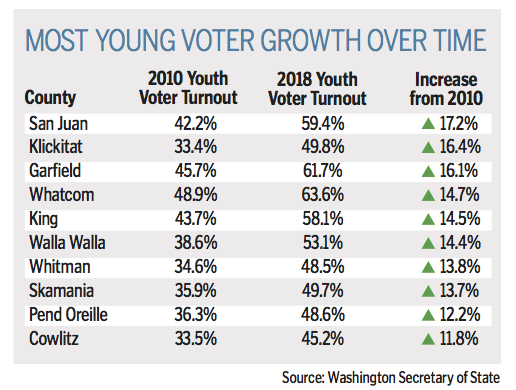
Whitman County has also seen significant growth in voter turnout, with young voters casting ballots at a rate of 13.8 percentage points higher than in 2010, according to data from the Secretary of State’s Office. About 1,700 more young people voted in that county than did eight years prior.
Washington State University’s Cougs Vote initiative, a coalition of student, staff and community groups, played a significant role in increasing Whitman County’s turnout last year. Volunteers ran voter registration drives and helped provide information to students who were registering to vote for the first time.
“We wanted to make sure we were helping students vote and be educated voters,” said Quinton Berkompas, deputy director of legislative affairs for the associated student body. “It was something that hadn’t been done before.”
Berkompas, 20, said volunteers collected 2,142 paper voter registration forms. Still others may have registered to vote online.
The campaign was so successful, Berkompas said, that the associated student body is editing its bylaws to mandate that it will focus on voter registration and education for every midterm and presidential election.
“We want to make sure we institutionalize it for the foreseeable future,” he said.
At the forefront
Young voters were at the forefront of political action in 2018. Students led marches and walkouts in the aftermath of the school shooting in Parkland, Fla. New York elected progressive candidate Alexandria Ocasio-Cortez to Congress, who at 29 is the youngest woman in history ever elected to Congress.
Opposition to President Donald Trump may also have motivated young voters. The Institute of Politics at Harvard University’s Kennedy School pointed to Trump’s low approval rating among young voters — 26 percent — as a driver of turnout.
Hillary Cordova, 19, graduated last summer from Fort Vancouver High School and voted for the first time in November. She said she was inspired by initiatives like Washington’s carbon tax, which failed, and by the shooting at Marjory Stoneman Douglas High School in Parkland, Fla.
Cordova, now a freshman at WSU Vancouver, helped organize a student walkout at her high school following that shooting.
“It was scary because throughout high school we had experienced so many school shootings,” Cordova said. “We wanted to voice our opinion. This needs to stop. We need to change.”
Cameron Kast, a 22-year-old WSU Vancouver senior, said he keeps a voters’ pamphlet in his backpack around election time to share with his friends, and encourages them to turn their ballots in as soon as they can. Kast worries about voter suppression in other parts of the country and the world, and believes voting is a fundamental human right.
“That’s what really motivates me the most is thinking ‘These are the things I believe in, and here’s a way to make it happen,’ ” he said.
Whether young voters remain energized in coming elections remains to be seen. But if people like Camas High School senior Merissa Landers are any indication, 2018 could have set a precedent for the years to come.
Landers, 18, was too young to vote November, but grew up listening to her politically opposite parents discuss current issues. Her mother gave her a voter registration form for her birthday.
And last year, she volunteered on Republican Larry Hoff’s winning campaign in the 18th Legislative District.
“I think it’s important to get involved when you’re young because then you find that issue you’re passionate about,” she said. “You can go for it and try to change something.”
How we did the story
We reported this story using data from four election years — 2010, 2014, 2016 and 2018 — obtained from the Secretary of State’s Office. The office breaks down voting by age group in each county for each election. Using Microsoft Excel and SQL, we developed a database representing the change over time for those four years.
Our story compares the 2018 election with the 2010 election as opposed to the 2014 election, the previous midterm. We decided that, since this was the first midterm under President Donald Trump, that comparing the numbers with President Barack Obama’s first midterm would more accurately represent how election demographics have changed.
New laws reduce barriers
Two new laws will go into effect June 1 that make county auditors optimistic about increasing youth voter turnout.
The first allows 16- and 17-year-olds to preregister to vote and the second allows people to register to vote on Election Day.
Washington is the 13th state to allow preregistration and the 16th state to allow same-day registration during an election. The prior law required voters to submit their registration at least 29 days before an election.
Thurston County Auditor Mary Hall said the laws should positively impact young voters.
“It will be very interesting to see the effect that has,” Hall said, specifically of same-day voter registration. “When we have to turn people away because they’ve passed the registration deadline, most of them are young people.”
